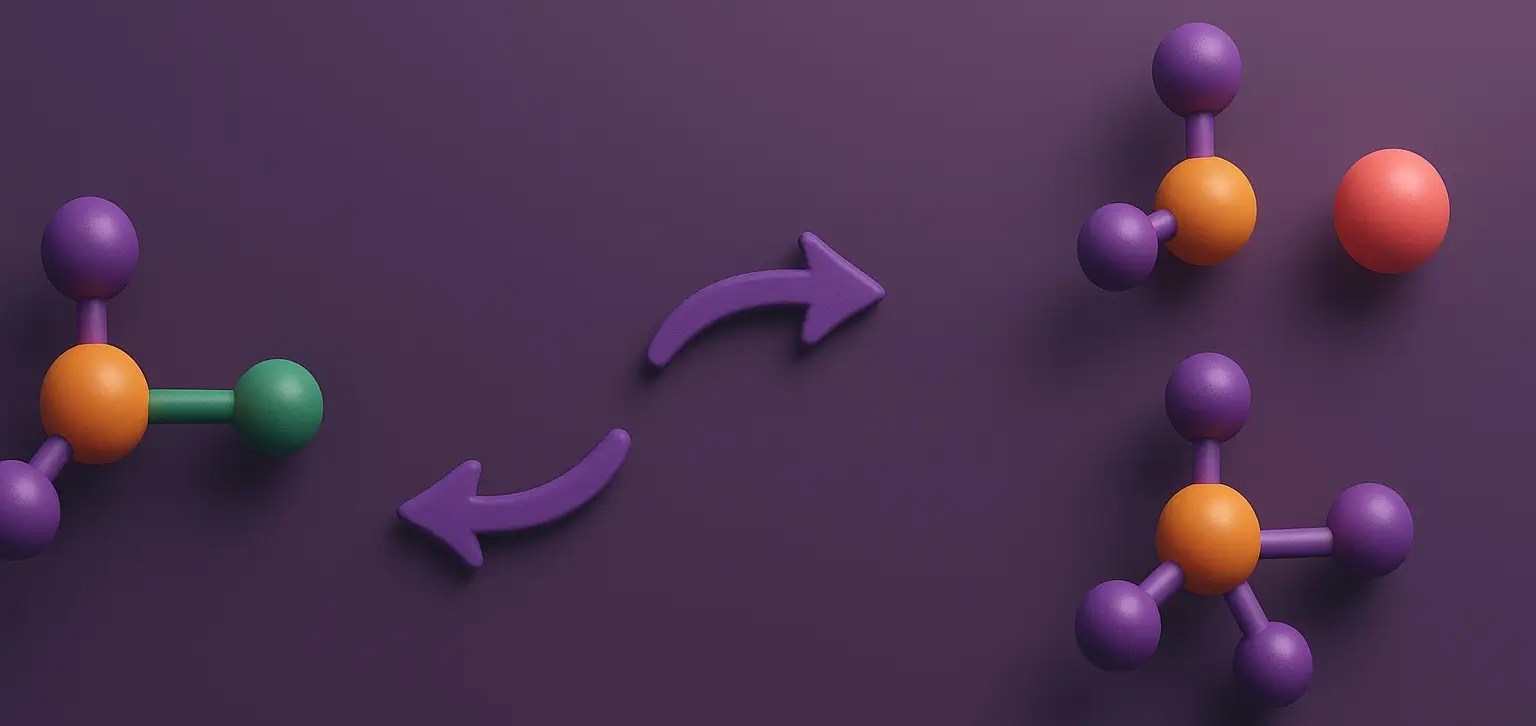SN1 and SN2 Reactions Definition
- SN1 and SN2 are types of nucleophilic substitution reactions.
- SN1 is a two-step reaction involving a carbocation intermediate and occurs mainly with tertiary halides in polar protic solvents. Its rate depends only on the substrate.
- SN2 is a one-step, concerted reaction where the nucleophile attacks as the leaving group departs, leading to inversion of configuration. It occurs with primary halides in polar aprotic solvents and its rate depends on both substrate and nucleophile.
SN1 Reactions
Kinetics of SN1 reactions
-
Definition:
- SN1 reactions follow first-order kinetics, where the reaction rate depends solely on the concentration of the alkyl halide.
-
Rate Equation:
-
${Rate} = k[\text{alkyl halide}$
- Here, k represents the rate constant, and [alkyl halide][\text{alkyl halide}][alkyl halide] denotes the concentration of the alkyl halide.
-
Order of Reactivity of Alkyl Halides
-
Reactivity Sequence:
-
Methyl halides > Tertiary (3°) > Secondary (2°) > Primary (1°)
-
-
Reasoning:
- The order is based on the stability of the carbocation intermediate formed during the reaction.
- Tertiary alkyl halides form the most stable carbocations, leading to higher reactivity.
- Methyl halides are the least reactive due to the instability of the methyl carbocation.
Stereochemistry of SN1 reactions
-
Racemization:
- SN1 reactions often result in the formation of a racemic mixture, meaning an equal mix of enantiomers (R and S configurations).
-
Mechanism:
- The carbocation intermediate is planar, allowing nucleophilic attack from either side.
- This leads to the formation of both possible enantiomers, causing racemization.
Rearrangement of Carbocations
-
Rearrangement Possibility:
- Carbocation rearrangement can occur during SN1 reactions if it results in a more stable carbocation.
- Common rearrangements include hydride shifts and alkyl shifts.
-
Stability Order:
- Rearrangements adhere to the general stability order of carbocations, favoring the formation of more stable carbocations.
Example of an SN1 Reaction: Reaction of 2-Bromopropane with Water
-
Formation of the Carbocation:
- CH3CHBrCH3 → CH3C+(CH3) + Br−
- The secondary (2°) alkyl halide, 2-bromopropane, forms a 2° carbocation intermediate.
-
Nucleophilic Attack by Water:
- CH3C + (CH3) + H2O → CH3CHOHCH3 + H+
- Water acts as a nucleophile, attacking the carbocation to form isopropanol.
-
Overall Reaction:
- CH3CHBrCH3 + H2O → CH3CHOHCH3 + HBr
- The reaction of 2-bromopropane with water yields isopropanol and hydrobromic acid.
SN2 Reactions
Kinetics of SN2 reactions
-
Definition:
- SN2 reactions follow second-order kinetics, meaning the reaction rate depends on the concentration of both the alkyl halide and the nucleophile.
-
Rate Equation:
- $Rate} = k [alkyl halide] [nucleophile]$
- Here, k is the rate constant, [alkyl halide] is the concentration of the alkyl halide, and [nucleophile] is the concentration of the nucleophile.
Order of Reactivity of Alkyl Halides
-
Reactivity Sequence:
- Methyl halide > Primary (1°) > Secondary (2°) > Tertiary (3°)
-
Reasoning:
- The order is due to steric hindrance, which affects the nucleophile’s ability to attack the carbon bonded to the leaving group.
- Methyl and primary alkyl halides are less hindered, making them more reactive.
- Tertiary alkyl halides are the least reactive due to significant steric hindrance.
Stereochemistry of SN2 reactions
-
Inversion of Configuration:
- SN2 reactions result in inversion of stereochemistry at the carbon center undergoing substitution.
- This is called Walden inversion.
-
Mechanism:
- The nucleophile attacks from the opposite side of the leaving group.
- This leads to a “backside attack”, causing inversion of configuration.
Carbocation Rearrangement
-
Lack of Rearrangement:
- SN2 reactions do not involve carbocation intermediates.
- Therefore, carbocation rearrangements do not occur.
-
Mechanism:
- The reaction proceeds through a single concerted step, where the nucleophile attacks as the leaving group departs simultaneously.
Example of an SN2 Reaction: Reaction of 1-Bromopropane with Sodium Hydroxide
-
Reaction:
- CH3CH2Br+OH−→CH3CH2OH+Br−
-
Process:
- The hydroxide ion (OH⁻) attacks the primary (1°) alkyl halide, 1-bromopropane.
- The attack occurs from the side opposite to the leaving bromide ion (Br⁻).
- This results in the formation of propanol (1-propanol) with inversion of stereochemistry at the carbon initially bonded to bromine.
Click Here to Watch the Best Pharma Videos

